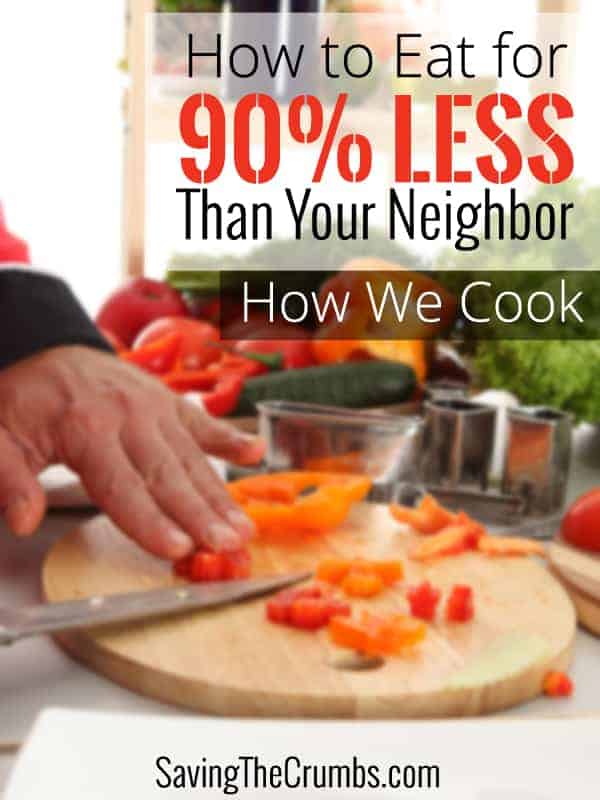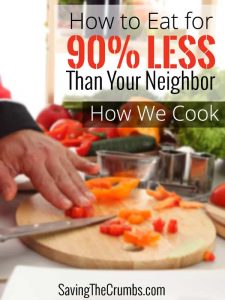In America, it seems like eating inexpensively is usually equated with eating unhealthfully: dollar meals at fast-food drive-thrus, cheap sodas, frozen pizza dinners. But it also seems like eating healthfully conjures up images of a rich, preppy lifestyle: expensive trips to Whole Foods, cure-all drinks extracted from exotic fruits, eating out at gourmet vegetarian cafes. Neither of these sound like good options to us. Our health and medical bills can’t afford getting sick eating cheap junk food, and yet our financial priorities can’t afford splurging on the upper echelons of a gourmet diet. So, in trying to find the balance between the two, we have ended up hopefully in a healthy yet affordable middle of the road. Here are just a few of the principles we found helpful in cooking simple, wholesome, and inexpensive meals.
Cook from Scratch
Not only is it healthier being able to control the ingredients of your meals, it can be considerably cheaper when you buy basic food staples and put them together yourself. Here are a few things we commonly make from scratch, but the possibilities are as broad as your cooking abilities and limited only by your own preferences.
| Granola | Ingredients for 20 cups of basic granola costs less than $3 (here’s our recipe). |
| Beans | A 2lb bag of dried pinto beans will make a full crockpot and costs $1.89. |
| Veggie Burgers | Compared to Morningstar burgers which are almost $1 each, a dozen homemade veggie burgers costs less than $2 when you just mix, shape, and bake oats, rice, veggies, and lots of flavorful seasonings. |
| Vegan Mayonnaise | I’ll admit, Vegenaise is king, but $6.49/jar is a little painful when I can make pretty acceptable mayonnaise out of a 79¢ block of tofu. |
| Pesto | One of those amazingly delicious gourmet foods that is super expensive to buy, but dirt cheap to make when you grow your own basil (here’s our recipe). |
| Eggplant Parmesan | A little time-consuming, but one of those things I make on a free day and freeze for future Italian nights. Why go to Olive Garden when 1 eggplant at ALDI is 99¢? |
| Vegan Nacho Cheese | One of my favorite recipes EVER makes smooth, super tasty nacho cheese out of…yes…potatoes and carrots. Think of it, half a VitaMix pitcher of vegan yumminess for less than $1! |
Choose Foods that are Not Time-Intensive
Because we are already spending extra time making food from scratch, we steer clear of making anything that requires a lot of assembly or too many steps. If it would be served at a formal wedding or girly baby shower, you probably won’t find it in our house. You know what I mean. All those cutely rolled, intricately layered, or precisely speared gourmet finger foods that take hours of fussing just to make it into something so pretty and dainty you almost can’t bear to eat it.
Of course, it doesn’t have to be something that is just served at formal occasions. Take a quick look through Pinterest, and you’ll find hundreds if not thousands of recipes that look amazing but also are amazingly time-consuming. For example, the hours put into making “Lasagna Cupcakes” for Valentine’s Day will definitely prove your “acts of service” love language, but you will rarely find me making lasagna, much less layering it into individual tiny muffin tins.
Instead, choose foods that are less time-intensive, where you can mix everything together instead of layering them or where you can cut the whole casserole dish with a couple quick swipes instead of rolling them into single servings. In the end, cooking efficiently will mean you can use your time to improve other priorities (like cooking healthfully from scratch), you’ll save money buying more basic ingredients, and it will soon be natural to be content with simple, unpretentious foods. Here are some of the foods we choose in order to optimize our time.
| Efficient | vs. | Laborious |
| Spaghetti, pesto, or vegan alfredo | vs. | Lasagna |
| Burrito bar | vs. | Enchiladas |
| Oven roasted Brussels sprouts | vs. | Skewers |
| Meatloaf | vs. | Meatballs |
| Potato soup | vs. | Stuffed potato skins |
| Make-your-own spring rolls | vs. | Egg rolls |
| Tofu stir-fry | vs. | Chinese dumplings |
| Cinnamon swirl bread | vs. | Cinnamon rolls |
Utilize Basic Ingredients
In my closet, there’s one black skirt that I have had forever. I love it. I wear it to church, as part of my choir uniform, to graduations, and about a gazillion other occasions that have come up through the years. It isn’t anything fancy. No elaborate patterns or unique designs. But because it goes with literally everything, I very rarely find myself needing to buy any other skirts. Why should I when this one goes with just about everything else in my wardrobe?
Transfer this principle to your kitchen. When you buy simple foods in their fairly natural state, they become the multi-use, basic building block ingredients for a million recipes. Stick to these items as much as possible and resist the urge to buy: 1) foods that will rarely be used in the rest of your cooking or 2) specialty foods that usually cost more than staple foods.
Here are a few examples. Instead of buying saffron which I would use only for saffron rice, I may opt to use turmeric and make curry fried rice since I already have turmeric on hand for Asian dishes and scrambled tofu. Instead of buying flavored instant oatmeal packets, we’ll buy a big carton of quick oats and use it for oatmeal, granola, veggie burgers, meatloaf, and cookies. Our oatmeal will be healthier, our purchase will stretch farther, and we’ll have fewer items to buy when we go grocery shopping.
Go Whole Grain
We all know that it’s healthy to eat whole wheat bread, but think about all the other grains out there that could be eaten complete with all their nutrients. Go with brown, red, black, or wild rice. Choose hulled barley instead of pearl barley. Pick stone-ground cornmeal or polenta instead of degerminated cornmeal. Add Shredded Wheat or Multi-grain Cheerios to your breakfast pantry. Yes, some of these whole-grain options are a bit more expensive, but before you write it off, consider the benefits of whole grain foods:
- Nutrients – Since we seem to be losing nutrients nowadays in every step from the farm to our table (GMO seeds, transportation to stores, microwaves, etc), this is an easy way to get much-needed vitamins, minerals, and protein into our diet.
- Improved health – As we’ve mentioned in previous posts, the purpose of Saving the Crumbs is to be able to live a meaningful life of service. And wouldn’t it be much more fulfilling to be able to do this with vitality and purpose, as opposed to being burdened down with medical bills and hindered by heart disease, obesity, cancer, or diabetes?
- Regularity – Good-bye constipation! (Need we say more?)
- Substantiality – I once visited an all-you-can-eat vegan buffet where they were serving brown rice, black beans, whole wheat lasagna with tofu, and lots of other whole and filling foods. I happened to overhear the cook commenting, “I’m not worried about people eating us out of business. How many plates of this kind of food can you eat?” And he definitely had a point! Another remarkable way whole grains save you money is that they’re substantial: you get full faster and you feel full longer.
- Flavor – Once you get used to the earthy, nutty, natural flavor of whole grain foods, you might actually think the white stuff is kind of bland!
*We use whole grains most of the time at home, but take the liberty to splurge every so often. So sometimes you’ll see us using regular pasta or white rice in sushi. We don’t believe that you can’t eat these things, but do believe that whole grains should be the rule and not the exception instead of the other way around.
So now you know how we learned to eat for 90% less than our neighbors…and perhaps much of American society! Not all of what we did will be the right fit for you, but even if you choose to put just a few of these strategies to use, I guarantee that you’ll notice a downward trend in your food bill before too long. But even better than saving a few crumbs, you will find yourself living efficiently, wisely, healthfully, simply, and before you know it….being content living life meaningfully on less.
How We Eat for Less Than $60 a Month: A Peek into Our Food Budget
How We Eat for Less Than $60 a Month: Part 1 – Our Philosophy
How We Eat for Less Than $60 a Month: Part 2 – What We Buy
How to Plan a Menu On a Budget










